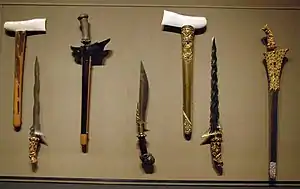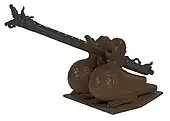| Kudi | |
|---|---|
_MET_36.25.1287_001July2014.jpg.webp) Kudi Tranchang (or Kudi Rancang), a talisman kudi with elaborate blade. | |
| Type | Billhook-Axe hybrid |
| Place of origin | Indonesia (Central Java) Banyumas |
| Service history | |
| Used by | Banyumasan people |
| Specifications | |
| Length | 30–60 cm (12–24 in) (blade), up to 180 cm (71 in) (handle) |
| Blade type | Single edge, convex grind |
| Hilt type | Wooden |
| Scabbard/sheath | Wooden |
A kudi or kudhi is a bladed tool from Banyumas, Indonesia.[1]
Description
Like a parang, a kudi only has one sharp edge, however, it has a rather curved shape blade tip like a sickle, with an enlarged base. Similarly to the parang, kudi can be used to chop or cut wood and bamboo.[1] Kudi with a slimmer blade may be used as a weapon. The hilt is usually made of wood that is at least as long as the blade. Some kudi blades are also fitted to a spear handle. In spear form, the length of the handle is usually between 65–180 cm (26–71 in).[2]
Culture
The kujang is often considered a development of the kudi.[3] It is said that the word "kujang" came from "kudi hyang" (Gods' kudi).[2] Banyumas version of Bagong puppet figures, called Bawor, depicted carrying a kudi (called curiga) as a weapon. Kudi is considered one of the cultural identities of the Banyumas people.[4] The kudi is typically worn as part of the Banyumasan traditional attire by girding on the back of the waist.[5]
Images
 Kudi Wayang, kudi with blade shaped like a wayang puppet figure.
Kudi Wayang, kudi with blade shaped like a wayang puppet figure. Common Banyumasan kudi.
Common Banyumasan kudi. Common Banyumasan kudi.
Common Banyumasan kudi.
See also
References
- 1 2 M. Koderi & Ahmad Tohari (1991). Banyumas: wisata dan budaya. Metro Jaya. p. 138. OCLC 25247099.
- 1 2 M, Rahmat (2010). Mengenal Senjata Tradisional. Jakarta: Pamularsih. ISBN 978-979-053-139-0.
- ↑ Albert G Van Zonneveld (2002). Traditional Weapons of the Indonesian Archipelago. Koninklyk Instituut Voor Taal Land. ISBN 90-5450-004-2.
- ↑ Darmawan L (2010). Kudi, Alat Kerja Sekaligus Senjata. Baviase.
- ↑ Y Sigit Widiyanto (2006). Hujan emas di tanah Selarong. Direktorat Jenderal Nilai Budaya Seni dan Film, Departemen Kebudayaan dan Pariwisata. p. 53. ISBN 97-915-6791-3.


